York Coaching Inns and the Great North Road
York’s strategic location as a transport hub and regional centre has been apparent for 2,000 years. Just as with the Roman roads before and the railways after, so York found itself the hub of many coaching routes. The Great North Road carried passengers the length of the country but there were dozens of other services radiating in all directions. These passengers needed somewhere to stay, as did the horses, their drivers and guards. York coaching inns flourished and had a major impact on the economic fortunes of the city for 200 years. The high point was after the road improvements associated with the turnpike trusts of the mid 18th century and prior to the arrival of the railways in the 1840s.
About York Coaching Inns
Writing in 1889, Tom Bradley provides us with sketches and notes on the York coaching inns. He suggests they were specialised in terms of the type of services offered:
“the Mails started from the York Tavern, which adjoined the Post Office, and the stage and light coaches from the Black Swan, the George confined itself principally to the posting business, and Etteridge’s provided relays of horses for noblemen and gentlemen travelling in their own private carriages. Of these four houses the York Tavern was the most important.”
Before we visit four of York’s famous coaching inns let Bradley capture the excitement and romance of York’s coaching era:
“How the Mails would come sweeping over the bridge and whip round the sharp corner into Spurriergate and along the narrow confined street to the Swan and the Tavern was wonderful, whilst the coachman’s skill, that could turn four bright bays round the corner of the Commercial Coffee House and out of Nessgate into Coppergate (which is so crooked and narrow that the houses on either side almost touch) and over its rough cobbles to the White Horse, was nothing short of marvellous, and needed such finished artists as rash Tom Holtby and scientific James Douglas to manipulate the ribbons. How the small, shrivelled, nervous old gent, in the white stiff choker, must have clung to the seat with both hands, and the antique maiden aunt shrunk into the depths of her poke-bonnet, as the coaches, with little abatement of speed, unexpectedly shaved the corners and jolted over the uneven pavement under the dark frowning gables of the quaint old city.”
The York Tavern, St Helen’s Square
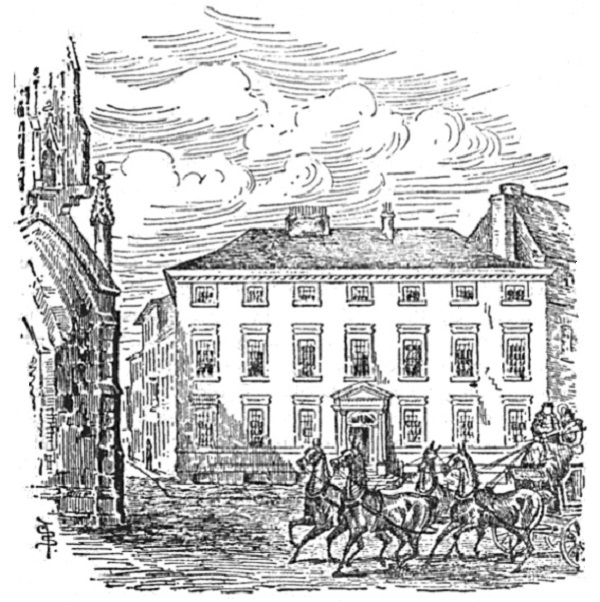
Coach leaving The York Tavern, Tom Bradley
The York Tavern was an important York coaching inn and was the start point for many of the Mail services. However, the building is long gone and the inn less well recorded than others. As with the Black Swan, “horsing” of the Mails and the post coaches was handled by Cattle and Maddocks who stabled more than 130 horses at a yard on the opposite side of St Helen’s Square, and separately at Tang Hall.
Castle and Maddocks worked with both the York Tavern and the Black Swan operating many of the York coach and mail services. If this list of magnificently titled services recorded by Tom Bradley is reliable then they would have been very busy:
The London and Edinburgh Mail
The Liverpool and Manchester Mail
The Liverpool and Manchester Old Mail
The Scarborough Mail
The Hull New Mail
The Whitby Mail
The Highflyer (London and Newcastle)
The Express (London and Carlisle)
The Wellington (London and Newcastle)
The Shields Royal Times
The Whitby Neptune
The Manchester and Liverpool Highflyer
The Leeds Wellington
The True Briton
The Prince Blucher
The Old True Blue (all three Leeds and Scarborough coaches)
The Hull Trafalgar
The Hull Rockingham
The Birmingham Coach
The Helmsley Highflyer
The Harrogate Highflyer
The Birmingham Ebor
The Nottingham Water Witch
The Sheffield Union
The Hull True Briton
The Sheffield Transit
The Harrogate Tally-Ho
The Scarborough Express
Towards the end of the coaching era the York Tavern was taken on by Christopher Harker and the establishment was renamed the Harker Hotel. The hotel was demolished in the late 1920s when the south side of St Helen’s Square was redeveloped: Betty’s Tea Rooms now stands roughly where it once stood. Harkers bar, which is on the other side of the square today, is named after the old hotel.
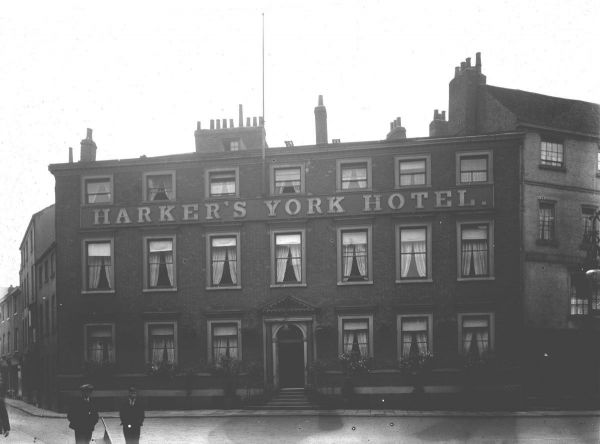
Harker’s Hotel prior to demolition in about 1929
The Black Swan, Coney Street
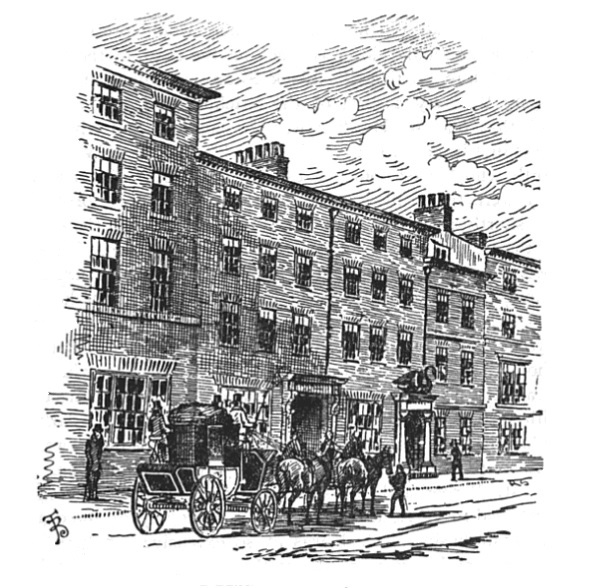
Coach approaching the Black Swan on the east side of Coney Street, Tom Bradley
The Black Swan was just to the south of the George on the opposite side of Coney Street. The 17th century structure was given a new façade and a fourth storey when the licensee, Ambrose Batty, was paid £90 by the Corporation as a consideration ‘for taking down and rebuilding in an upright line’. While Harper is critical of its red brick, drab architecture, he writes that:
From the purely coaching point of view, the ‘ Black Swan ‘ is the most interesting of York’s hostelries. To the York Tavern came the mails, while the ‘Black Swan’ did the bulk of the stagecoach business, from the beginning of it in 1698 until the end in 1842. It was here that the old ‘York in Four Days’ coaching bill of 1706 was discovered some years ago.
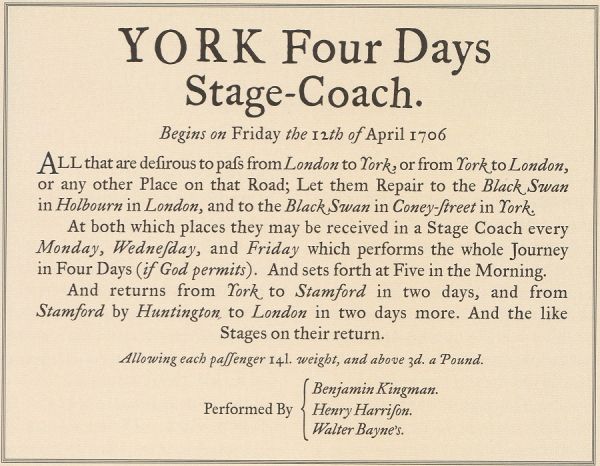
1706 announcement of the 4 day service between the Black Swan in London and the Black Swan in York.
This was at a time when the stagecoaches were just starting to gain momentum so places The Black Swan as one of the oldest coaching inns. The first mail coaches started to run in 1786 and again the Black Swan became an active player. By the early 19th century the inn was run by James Barber who worked closely with Cattle and Maddocks.

Cattle and Barber tokens were minted in a neighbouring Coney Street silver smith’s shop (Photo Credit – British Museum)

The sign of the Black Swan, Coney Street has been removed to the York Castle Museum
[NB Take care not to confuse this hostelry with another ancient inn which still survives – The Black Swan, Peasholme Green, York]
The George Inn, Coney Street

A sketch by Tom Bradley captures the splendour of the earlier George Inn rather more conscientiously than the stylised image by John Charles Maggs at the top of this page.
The George Inn was located in Coney Street close to the church, St Martin le Grand. The site has a long history stretching back to an 11th century synagogue. Various prominent local citizens subsequently lived there before it became an inn – The Bear, The Golden Lion and then the George in 1614, under Thomas Kaye, Sheriff of York. The original medieval timber framed building was given a brick façade mounted on stone columns in 1716 though it retained a 15th century timber porch and a boss carved with a Pelican in Piety. The large galleried quadrangle and stabling extended back to the river.
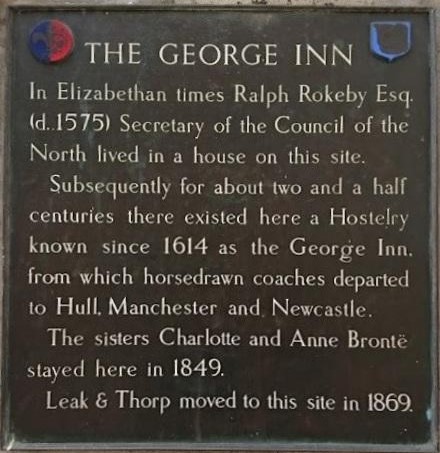
The George Inn, York Civic Trust Plaque
Harper describes the George as a:
“picturesque old house, which rejoiced in a sixteenth-century frontage, heavily gabled and enriched with quaint designs in plaster, and a yawning archway, supported on either side by curious figures whose lower anatomy ended in scrolls, after the manner of the Renaissance. The ‘George’ for many years enjoyed an unexampled prosperity, and the adjoining houses, of early Georgian date, with projecting colonnade, were annexed to it. When it went, to make way for new buildings, York lost its most picturesque inn.”
The George long held the position of being the principal posting house in the city. Even before the coaching trade developed there is a record of post-horses being kept at the inn. By the 19th century there were as many as 10 postboys under the management of Mrs Winn who “had a monopoly of almost all the posting houses between York and Scarborough.” Towards the end of the coaching days a coach called the Highflyer used to run daily from the George to the Blacksmith’s Arms at Scarborough daily. In 1807 the Trafalgar service to Newcastle ran daily from the George calling at Yarm, Stockton, Sunderland: it left York at 2am and after an overnight stop in Newcastle proceeded to Edinburgh and Glasgow the next day.
As one of York’s leading coaching inns the George had its share of celebrated guests: among them the architect John Vanbrugh, who stayed at the inn while he was designing Castle Howard. In May 1849 an ailing Anne Bronte stayed at the George with her sister Charlotte en route from Haworth to Scarborough.
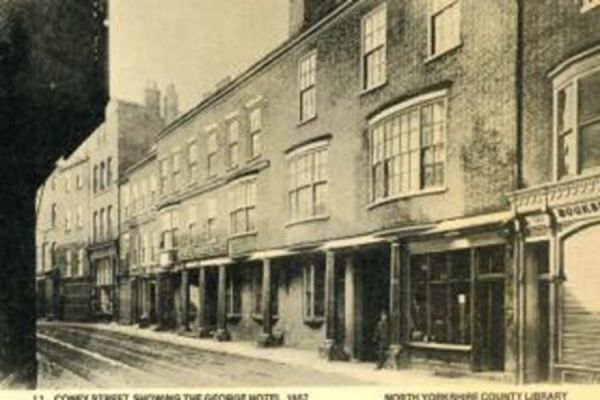
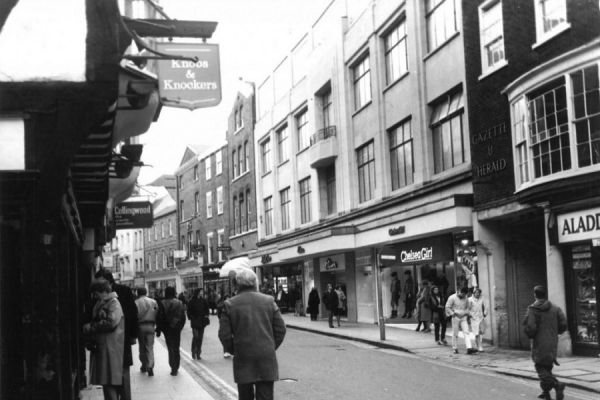
An 1867 postcard showing the George. The building was demolished 2 years later to make way for a department store (rebuilt again in the 1930s). One of the bay windows and a Tuscan column were retained and are still visible in the 1973 image.
The White Swan, Goodramgate
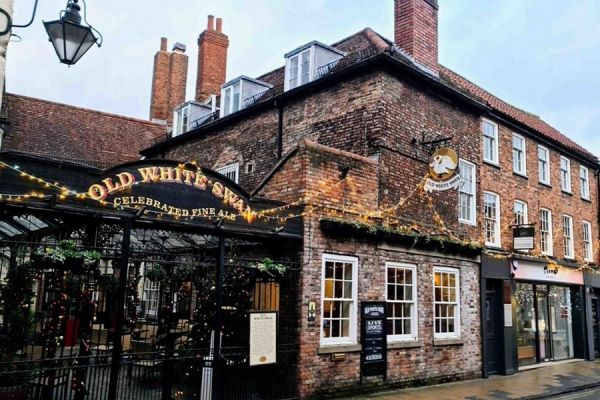
The White Swan in Goodramgate still survives as a pub in the city centre of York (dubbed since 1885 as the Old White Swan). The core of the building is timber-framed and was constructed in the early-17th century, when the yard at the back also had an entrance from Low Petergate. A mounting block gives clues to its coaching past: a Roman column beneath a glass panel in the floor is not in its original position so tells us rather less.
The building was in use as an inn by 1703, making it the third oldest in the city. Brick extensions were added to either side of the original building and the frontage on Goodramgate was rebuilt in the 18th century.
The building straddles the parish boundary between Holy Trinity King’s Court and Holy Trinity Goodramgate: the landlord used to paint a white line through the courtyard and kitchen to demarcate the boundary and justify payment of only partial rent to each parish. Innovative landlords apparently were creative in attracting business: a poultry market was sometimes held in the courtyard; in 1781 Patrick Cotter O’Brien was presented here as the world’s tallest man at 8 feet; and long before the Guinness book of records a man attempted to eat ten pounds of tripe.
In the late-18th and early-19th century, the inn was the starting point for several stagecoach routes, including one to Glasgow via Durham and Newcastle, and shorter ones to Easingwold and Helperby.
[NB There was another White Swan coaching inn facing onto Pavement, but it was pulled down when Piccadilly was redeveloped in the late 19th century.]

